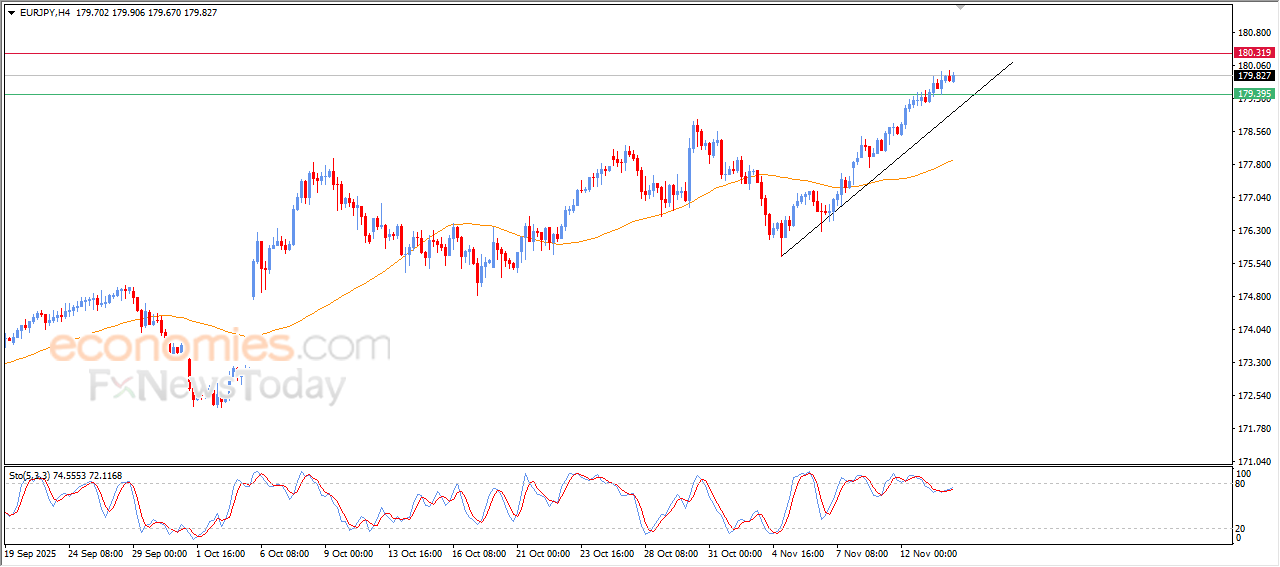Category: Forex News, News
Buyers remain interested on US economic uncertainty
EUR/USD rose nearly 0.4% and closed the third consecutive day in positive territory on Thursday. The pair fluctuates in a tight channel above 1.1600 in the European morning on Friday and remains on track to post weekly gains.
The US Dollar (USD) continued to weaken against its major rivals on Thursday as cautious remarks on further policy easing, combined with a lack of clarity on how the data backlog that built up during the government shutdown will be handled, fed into concerns over the economic outlook.
Federal Reserve (Fed) Bank of St. Louis President Alberto Musalem said that he expects the labor market to stay around full employment and added that they need to proceed with caution now. Meanwhile, Minneapolis Fed President Neel Kashkari reiterated that inflation is still too high.
According to the CME FedWatch Tool, markets are currently pricing in about a 52% probability of a 25 basis points (bps) Fed rate cut in December.
The economic calendar will not offer any high-impact data releases that could trigger a noticeable market reaction. Hence, investors will continue to pay close attention to remarks from Fed officials.
Although hawkish remarks are usually seen as supportive for the USD, investors could refrain from betting on a steady recovery in the currency until they have a better idea about what kind of shape the US economy is in the shutdown aftermath.
EUR/USD Technical Analysis
In the 4-hour chart, EUR/USD trades at 1.1637, little changed on a daily basis. The Simple Moving Averages (SMA) tilt higher at the short end, with the 20- and 50-period lines rising as price trades above all key averages. The 100-period SMA is turning up, while the 200-period SMA extends a mild decline. The 20-period SMA at 1.1598 offers nearby dynamic support. The Relative Strength Index (RSI) sits at 67.7, near overbought and consistent with firm bullish momentum. Measured from the 1.1885 high to the 1.1471 low, resistance comes at the 50% retracement at 1.1678 and the 61.8% retracement at 1.1727.
Support is seen at 1.1551, then at 1.1451. As long as the pair holds above the rising short-term averages, the bias would remain upward and a break through initial Fibonacci resistance could extend the advance toward higher retracement objectives. Conversely, loss of the nearby dynamic support would slow the upside and risk a pullback toward the stated horizontal levels.
(The technical analysis of this story was written with the help of an AI tool)
Euro FAQs
The Euro is the currency for the 20 European Union countries that belong to the Eurozone. It is the second most heavily traded currency in the world behind the US Dollar. In 2022, it accounted for 31% of all foreign exchange transactions, with an average daily turnover of over $2.2 trillion a day.
EUR/USD is the most heavily traded currency pair in the world, accounting for an estimated 30% off all transactions, followed by EUR/JPY (4%), EUR/GBP (3%) and EUR/AUD (2%).
The European Central Bank (ECB) in Frankfurt, Germany, is the reserve bank for the Eurozone. The ECB sets interest rates and manages monetary policy.
The ECB’s primary mandate is to maintain price stability, which means either controlling inflation or stimulating growth. Its primary tool is the raising or lowering of interest rates. Relatively high interest rates – or the expectation of higher rates – will usually benefit the Euro and vice versa.
The ECB Governing Council makes monetary policy decisions at meetings held eight times a year. Decisions are made by heads of the Eurozone national banks and six permanent members, including the President of the ECB, Christine Lagarde.
Eurozone inflation data, measured by the Harmonized Index of Consumer Prices (HICP), is an important econometric for the Euro. If inflation rises more than expected, especially if above the ECB’s 2% target, it obliges the ECB to raise interest rates to bring it back under control.
Relatively high interest rates compared to its counterparts will usually benefit the Euro, as it makes the region more attractive as a place for global investors to park their money.
Data releases gauge the health of the economy and can impact on the Euro. Indicators such as GDP, Manufacturing and Services PMIs, employment, and consumer sentiment surveys can all influence the direction of the single currency.
A strong economy is good for the Euro. Not only does it attract more foreign investment but it may encourage the ECB to put up interest rates, which will directly strengthen the Euro. Otherwise, if economic data is weak, the Euro is likely to fall.
Economic data for the four largest economies in the euro area (Germany, France, Italy and Spain) are especially significant, as they account for 75% of the Eurozone’s economy.
Another significant data release for the Euro is the Trade Balance. This indicator measures the difference between what a country earns from its exports and what it spends on imports over a given period.
If a country produces highly sought after exports then its currency will gain in value purely from the extra demand created from foreign buyers seeking to purchase these goods. Therefore, a positive net Trade Balance strengthens a currency and vice versa for a negative balance.
Written by : Editorial team of BIPNs
Main team of content of bipns.com. Any type of content should be approved by us.
Share this article:








